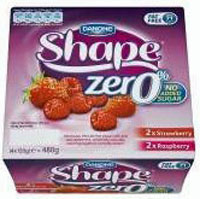 Ingredients
Ingredients-
- Skimmed milk
- Fruit (6%): strawberry
- Skimmed milk powder
- Milk powder
- Fibre: guar gum, oligofructose
- Stabilisers: modified maize starch, carrageen
- Flavouring
- Acidity regulators: sodium citrate, citric acid
- Yogurt cultures
- Colour: cochineal
- Sweeteners: aspartame, acesulfame K
Published March 2010
This claims to make you 'feel fuller for longer' which it does by having a higher level of fibre that the digestive system cannot break down so it remains in the stomach for longer.
Ingredients
Milk comes in the form of skimmed milk, skimmed milk powder, and milk powder.
Fibre is carbohydrate which our digestive enzymes cannot break down so making the stomach 'feel fuller for longer'. Here it comes as guar gum (aka E412) which is extracted from the beans of the guar bush and these are grown mainly in India and Pakistan. Guar gum consists of long chains of mannose molecules with galactose molecules attached. These are the carbohydrates that resist being digested. Guar gum also finds use in paper making and oil recovery. It strengthens the former and increases production of the latter. It is used to make a slurry with sand which is pumped under high pressure down into the oil-bearing rocks which breaks up thereby releasing more oil. The other carbohydrate is oligofructose which can be extracted from chicory or made from sugar. This carbohydrate feeds the good bacteria in our intestines. It also has a creamy 'mouth-feel'.
Stabilisers prevent the other ingredients from separating so you don't get solids at the bottom of the yoghurt carton and a liquid layer on top. Here the stabilisers are carbohydrates: modified maize starch, aka cornflour, and carrageen which is extracted from seaweed and is a galactose polymer. Carrageen (aka E407) can thicken most liquids and is also used in cosmetics, shampoos, sexual lubricants, and fire-fighting foams.
Acidity regulator consists of citric acid (aka E330) and its sodium salt, sodium citrate, which together prevent the pH of the yogurt from changing and becoming too acidic. Citric acid is the natural acid found in citrus fruits. Its chemical formula is C6H8O7 and the molecule contains three acid groups.
Colours
The pink colour of the yogurt derives from cochineal (aka E120) which is obtained from the female scale insect (Dactylopium coccus) which lives on cacti. The insects produce the intensely red carminic acid molecule to protect themselves against predators. They are harvested by hand and it takes 150,000 insects to yield a kilogram of the dye. The insects are killed by heating and then ground to a powder. The dye molecules are extracted with a solution of ammonia or sodium bicarbonate. Historically cochineal was used mainly to dye cloth as with the traditional redcoat uniforms of the British Army. Cochineal has come back as a food colorant because of the mistaken belief that artificial food dyes cause hyperactivity in children.
Sweeteners provide the sensation of sweetness without adding calories. Aspartame (aka Canderel, E951), is based on two amino acids of the kind that make up proteins, whereas acesulfame K (aka E950) is entirely synthetic and is a molecule containing sulfur and nitrogen atoms. The two chemicals boost each other's sweetness.